DECC EDUCATORS AMONG THOSE IN ATTENDANCE AT THE PARADIGM PROJECT POP-UP CONFERENCE IN AUGUST
12/14/2022 01:48:48 PM
 Pictured left to right: Steph Brown, Sammi Dubois, Lesley Goldenberg, and Bobbi Pernikoff
Pictured left to right: Steph Brown, Sammi Dubois, Lesley Goldenberg, and Bobbi Pernikoff
In mid-August, many of the DECC educators and I had the opportunity to attend the Paradigm Project Pop-Up Conference. This St. Louis pop-up was sponsored by the Paradigm Project and the Jewish Early Childhood Centers Directors Council, supported by The Jewish Federation of St. Louis, and in partnership with the Sheva Center for Innovation in Early Childhood Jewish Education and Engagement.
The conference opened with a session with Sarah Hassing, a preschool teacher at the College School here in St. Louis. She presented the notion that children are capable, confident, and curious learners who enter our classrooms with their own theories on the world. She asked us to think about our own work in the classroom and whether we are presenting activities or investigations to our students.
An activity has a specific focus with a set beginning, middle, and end. Think of a unit where a class would be learning about the seasons, with a focus on fall. An activity might be to create a fall tree; the teachers would provide the children with red, yellow, orange, and green paints with brushes that create strokes that look like leaves; brown paper to make a trunk and white paper as a base to create the tree. As an adult, if we walked into a classroom and saw these supplies, we would likely guess that the children would be working on creating a fall tree. Every tree will turn out differently; they will all be beautiful and unique.
An investigation is more driven by the students and is open-ended. Think of a similar unit on fall, with the children playing in a large sensory bin. In that bin are both real and plastic leaves in a variety of fall colors, plus pinecones and sticks from outside and foam bases to build something on. Some children may see these materials and decide they want to construct a fall tree, figuring out on their own how to attach a stick to a base and then how to affix the leaves to that stick. Another child might depict what the ground looks like in the fall, choosing to glue the leaves directly to the foam base. And yet another child might not even create anything; he might just play and explore, making observations about the colors of the leaves or the texture of the pinecones.
The same theories can be applied to how a playground is constructed. If you visit some of the beautiful playgrounds we have around St. Louis, you will immediately understand how the equipment is intended to be used. A tunnel is to climb through; a playhouse is for playing family or restaurant, and a seesaw is to sit on and go up and down. But during our conference, we took a field trip to the new Anne O'C. Albrecht Nature Playscape in Forest Park. The website describes the playscape as an “experiential play space with natural landscapes with the goal of encouraging visitors — especially kids — to connect with nature as they engage their senses as they explore, discover, and learn." It was inspiring to visit the playscape and observe how children interact with the structures and create their own play narratives.
During our conference, we spent time discussing which of the above approaches is correct. How do children learn best, and should we be dedicating our time to planning activities or investigations? In my work as the DECC director, I spend a lot of time both observing the children in our program and the play they’re doing. It’s really inspirational watching our DECC teachers engage our children and figure out how they learn best. Our school is truly a mixture of activities and investigations, and as an educator, I ultimately believe that children learn best through a variety of hands-on activities and approaches, both teacher-led and child-led.
Pedagogy aside, the best thing we can do for our children is to support their individual journeys and observe how they discover the world. This conference reopened my eyes to the beauty of the process — and not necessarily the product — and how children have their own emerging, unique, and valuable opinions. What a blessing to watch our children grow!
B'shalom,
Lesley Goldenberg
Director of Family Education
lgoldenberg@ti-stl.org | 314-432-8076



